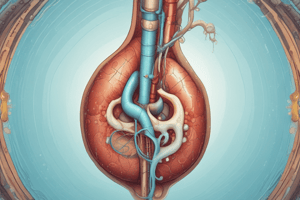Podcast
Questions and Answers
How do terrestrial organisms regulate internal water?
How do terrestrial organisms regulate internal water?
- By reducing water loss through evaporation only
- Through a balance of acquisition and loss (correct)
- By solely relying on water absorption
- By excreting excess water as concentrated urine
What challenges do freshwater fish face in terms of water and salt balance?
What challenges do freshwater fish face in terms of water and salt balance?
- Hyperosmotic conditions (correct)
- Anosmotic conditions
- Hypoosmotic conditions
- Isosmotic conditions
How do marine bony fish regulate salt balance?
How do marine bony fish regulate salt balance?
- By reducing salt intake through specialized filtration organs
- By relying on the salt content of the marine environment
- By excreting excess salt through gills
- By drinking seawater and having specialized cells for salt balance (correct)
What determines water movement in aquatic environments?
What determines water movement in aquatic environments?
How do small terrestrial animals acquire water?
How do small terrestrial animals acquire water?
What is discovery science?
What is discovery science?
What is a research question?
What is a research question?
What must a hypothesis be?
What must a hypothesis be?
What is the role of a hypothesis in inquiry?
What is the role of a hypothesis in inquiry?
What is the first step in the scientific method?
What is the first step in the scientific method?
Why does the feeding rate increase slowly at low prey densities?
Why does the feeding rate increase slowly at low prey densities?
What contributes to the S-shaped curve of the functional response?
What contributes to the S-shaped curve of the functional response?
In Type III functional response, at what prey densities does the feeding rate increase fast?
In Type III functional response, at what prey densities does the feeding rate increase fast?
What do animals often do at low prey densities?
What do animals often do at low prey densities?
What may animals require at low prey densities to exploit food?
What may animals require at low prey densities to exploit food?
Evaporation is a significant cause of water loss for organisms in aquatic environments
Evaporation is a significant cause of water loss for organisms in aquatic environments
Diffusion and osmosis determine water movement in terrestrial environments
Diffusion and osmosis determine water movement in terrestrial environments
Terrestrial plants regulate internal water through a balance of gain and loss
Terrestrial plants regulate internal water through a balance of gain and loss
Desert animals have specialized water acquisition methods
Desert animals have specialized water acquisition methods
Freshwater fish drink seawater and have specialized cells for salt balance
Freshwater fish drink seawater and have specialized cells for salt balance
Discovery science focuses on the analysis of small volumes of experimental data
Discovery science focuses on the analysis of small volumes of experimental data
A hypothesis is an idea or explanation that cannot be tested through study and experimentation
A hypothesis is an idea or explanation that cannot be tested through study and experimentation
A research question must be clear, easy to understand, and specific with a definite focus
A research question must be clear, easy to understand, and specific with a definite focus
The first step in the scientific method is to make an observation
The first step in the scientific method is to make an observation
The feeding rate increases fast at low prey densities in Type III functional response
The feeding rate increases fast at low prey densities in Type III functional response
Flashcards are hidden until you start studying
Study Notes
Water Regulation in Terrestrial and Aquatic Environments
- Evaporation is a significant cause of water loss for organisms on land, influenced by temperature and air water content
- Diffusion and osmosis determine water movement in aquatic environments
- Terrestrial organisms face challenges of water loss through evaporation and reduced access to replacement water
- Terrestrial animals regulate internal water through a balance of acquisition and loss
- Terrestrial plants regulate internal water through a balance of gain and loss, including water absorption and transpiration
- Small terrestrial animals can absorb water from the air, while desert animals have specialized water acquisition methods
- Camels and Saguaro Cacti have unique approaches to acquiring, storing, and conserving water in desert environments
- Aquatic organisms have different challenges in water and salt balance, with freshwater fish facing hyperosmotic conditions and marine bony fish facing hypoosmotic conditions
- Freshwater fish absorb water through their gills and excrete excess water as dilute urine, while marine bony fish drink seawater and have specialized cells for salt balance
Water Regulation in Terrestrial and Aquatic Environments
- Evaporation is a significant cause of water loss for organisms on land, influenced by temperature and air water content
- Diffusion and osmosis determine water movement in aquatic environments
- Terrestrial organisms face challenges of water loss through evaporation and reduced access to replacement water
- Terrestrial animals regulate internal water through a balance of acquisition and loss
- Terrestrial plants regulate internal water through a balance of gain and loss, including water absorption and transpiration
- Small terrestrial animals can absorb water from the air, while desert animals have specialized water acquisition methods
- Camels and Saguaro Cacti have unique approaches to acquiring, storing, and conserving water in desert environments
- Aquatic organisms have different challenges in water and salt balance, with freshwater fish facing hyperosmotic conditions and marine bony fish facing hypoosmotic conditions
- Freshwater fish absorb water through their gills and excrete excess water as dilute urine, while marine bony fish drink seawater and have specialized cells for salt balance
Studying That Suits You
Use AI to generate personalized quizzes and flashcards to suit your learning preferences.




